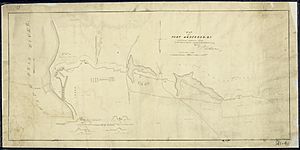Fort Anderson (North Carolina) facts for kids
Fort Anderson was an important fort built in the mid-1800s in North Carolina. It was made of earth and stood on top of the old town of Brunswick. During the American Civil War, this fort was used by the Confederate army. Its main job was to protect the Cape Fear River and the city of Wilmington from Union ships.
The fort had large dirt walls called "earthen batteries." These walls were used to hold cannons and protect the soldiers firing them. Underneath some of these dirt mounds were "bombproofs." These were shelters where troops could hide during enemy attacks. The Confederacy built forts like Anderson along the Cape Fear River to keep the port of Wilmington safe from the Union blockade. During the war, special ships called blockade runners brought important supplies like iron, guns, and ammunition to the Confederacy. Fort Anderson helped these ships get safely up the river. The fort was first named Fort St. Philip, but its name was changed to honor Colonel George B. Anderson.
Contents
Discovering Fort Anderson's Past
Early Explorations
In 1951, a man named Lawrence Lee started exploring the land where Brunswick Town and Fort Anderson once stood. He quickly realized how important this historical site was. Because of his work, the area was officially recognized as a historic site. The family who owned Orton Plantation sold most of the land to the State Department of Archives and History for just one dollar. The Episcopal Diocese of East Carolina also sold their part of the land for one dollar.
Seven years later, Lawrence Lee led the effort to uncover the site. This excavation revealed many things, including the old streets of Brunswick Town and the foundations of houses.
Archaeological Finds
In 1958, Stanly South, a professional archaeologist, joined the project. Over the years, he and his team found many old objects and the remains of buildings. They discovered about sixty important archaeological features.
In April 1967, a visitor center opened at the site. Its goal was to teach people about the history of both Brunswick Town and Fort Anderson. However, in 1968, the North Carolina Department of Cultural Resources stopped all excavations in state parks because of money problems. This issue still affects archaeological work today.
Modern Excavations
Today, under the guidance of Professor Tom Beaman, new excavations have begun. They are exploring the Civil War barracks at the site. Students from Peace College, Summer Ventures, Wake Technical College, UNCW, and many other volunteers have helped with this work. Exciting new artifacts are still being found, and archaeologists plan to keep digging at Fort Anderson in the future.
Visiting the Historic Site
The Fort Anderson site is managed by the North Carolina Department of Natural and Cultural Resources. They run the area as the Brunswick Town/Fort Anderson State Historic Site. The visitor center has exhibits and a video that tell the story of both the colonial port of Brunswick Town and the Civil War-era Fort Anderson. Outside, walking trails lead visitors past displays and the excavated ruins of the fort and town.
Images for kids



